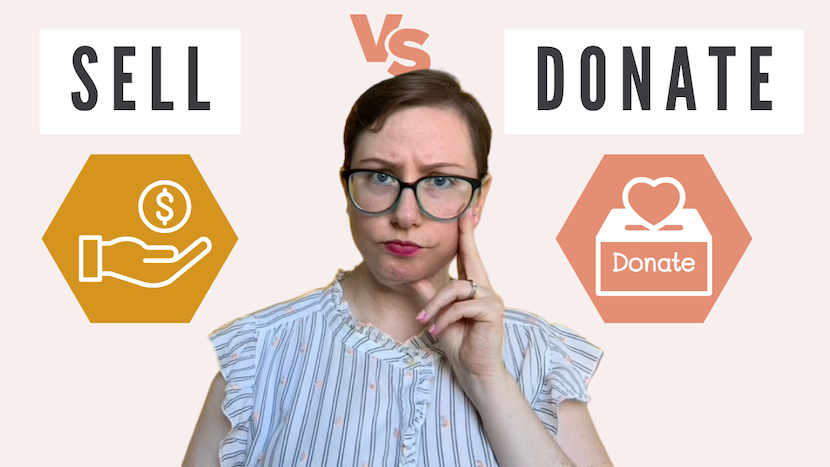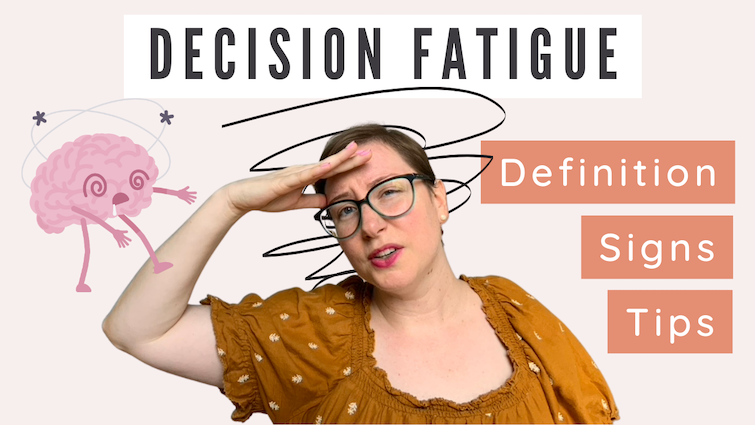What’s the KonMari Method, and what is it not (4 KonMari Myths)?
For the last few years, the KonMari Method® had a lot of media attention through the two Netflix Shows with Marie Kondo. However, the assumption that everybody has heard of what the KonMari Method® is isn't true. People “heard of it,” but there are also many myths and misunderstandings out there.
So, let’s clarify this in this blog post! 😉 Or, if you prefer to watch it, then you can also watch the video above.🎥
Who is Marie Kondo?
Marie Kondo invented the KonMari Method ®. It's a combination of her first and last name in reverse: Kondo Marie.
Marie Kondo is originally from Japan. She started decluttering and organizing as a young girl and later created a full-time business out of it. When she released her book "The life-changing magic of tidying up," she became a bestselling author. This is also how I heard about her in 2015/16.
What's the KonMari Method?
First, you do it only once in your life. Marie Kondo calls it a "Tidying Festival," meaning you are tidying all of your belongings. You don't do it ten minutes a day, but you do it for several hours per session so that you can be finished in a few weeks or months, and it won't drag out for longer than necessary.
Once you finish, you can still maintain all things you decided to keep. Also, it's essential to remember that the person you are today may not be the person you are in a few months or years. So you might have different goals in the future, and it's ok to revisit everything and declutter some areas again. But the vast amount of things that you have at the beginning you wouldn't need to face again. The big "Tidying Festival" you only do once.
The second important part of the KonMari Method® is that you don't think about, "What do I want to discard?" You think about, "What is so precious and sparks joy in my life that I want to keep it in my life?"
Using the KonMari Method® is a chance to reset your whole life and change your mindset. Not just about the items you own but also your relationships and hobbies. Even your work and everything that's part of your life. It doesn't stop with your belongings but goes broader and more profound.
The KonMari Method has six basic rules of tidying:
KonMari Method Rule #1: Commit yourself to tidying
It doesn't mean you feel like it for one afternoon, but that you commit your time and answer questions like: When do you tidy? How long do you tidy? Do you need help doing this, or do you do it yourself? Where do you bring all the things you don't want anymore that don't spark joy? Clear time boundaries that you can schedule. For example, I start the Tidying Festival by setting three hours of tidying each Saturday and Sunday morning. I will do this for three months and see how far I get. It can also mean you declutter every evening after work for two hours and try this as an experiment. No need for perfection, but for trying out what can work for your situation. Trial and error.
KonMari Method Rule #2: Imagine your ideal lifestyle
This is a very, very important point because you need to imagine what your lifestyle goal is. Knowing this goal serves you as a compass for all the following decisions. It's like Google Maps, you need to type in the destination, and then Google Maps can give you routes to go there. If you aren't clear on your destination, you won't be reaching it. That's the same with tidying.
Many of my clients aim for a less cluttered and calmer home environment. They long for free surfaces and want to feel soothed and supported by their surroundings. They also want to own fewer things and only keep the items that bring them closer to their life goals. Other clients aim to become minimalists or to let go of painful memorabilia. Each of us has our own story and dream of how we want to live our life. Start dreaming and planning! A vision board can be helpful, or you can write or draw a mind or dream map.
KonMari Method Rule #3: Finish discarding before you start organizing
You might think, "Duh, Kati, this is obvious!" But it's easy to get distracted because usually organizing is more fun and creative, and discarding can be challenging and uncomfortable. Still, keep at it and discard first, and decide what to do with each discarded item. Are you going to sell, donate, gift, recycle, or trash it? Only when this is clear, and you are left with the joy-sparking items from one category, then you can organize them.
KonMari Method Rule #4: Tidy by category and not by location
A lot of organizers say, "Start with a drawer." The KonMari Method ® teaches it differently. Here's an example: You might have a ton of pens, and they are not just in one drawer. There might be pens in your office, on your kitchen counter, and all over the place in your home. If you just organize all the pens in one area, what's with all the other pens in the rest of your home? It would feel like you never finish pens because you discover more pens every time you start with a new drawer or room. That's why you tidy by category and not by location. It helps to keep your sanity!
KonMari Method Rule #5: Follow the right order of the categories
There are five big KonMari categories: Clothes, books, paper, Komono (miscellaneous), and sentimental. Following this order is helpful because clothes are usually the easiest to decide on, and sentimental items are the most challenging. It's like in the gym; you start building your strength gradually. Sentimental items are like heavy weights. Be patient and keep them until the end.
KonMari Method Rule #6: Ask yourself if it sparks joy
The criteria to find out what to keep in your ideal life is to hold each item and ask yourself if it sparks joy. It's a combination of what you feel in your heart and how your body reacts to this item. You might feel lighter, uplifted, joyful, or grateful. It takes some time to recognize what "Does it spark joy?" means for you. That's why starting with clothes gives you easier clues. You can start with your favorite shirt and see how it makes you feel, and then compare it with a shirt that you know you don't like anymore and feel the difference in your heart and body.
When my clients do this, and if they aren't sure, I tell them what I see in their facial expressions and body language. I can see what joy or dislike looks like and reflect it to them so they can make an informed decision. So if you aren't sure and are doing this by yourself, look in the mirror and see how you react to a particular item. Does it spark joy, or does it spark something else? And because you imagined your ideal lifestyle, you know what you want.
This sums up what the KonMari Method® is.
Now, let's talk about what it is not!
KonMari Method Myths
Myth #1: The KonMari Method is not a permission slip to keep everything that sparks joy
This might be a little bit controversial. However, your joy is connected to your ideal lifestyle. If your ideal lifestyle is to live simpler and with fewer belongings, you must be open to letting some items go that don't serve the purpose of your new goal. And that can be hard. If your goal is to have only one dresser, but right now you have enough clothes to fit into two dressers and two wardrobes, then you have to see what sparks more joy—the ideal lifestyle of only one dresser or keeping all the clothes? Or maybe you find a compromise solution. In the end, it has to work for you! You do you! You define the boundaries. Trial and error is ok.
Myth #2: The KonMari Method is not a permission slip to shop thoughtlessly
As soon as you have developed your joy-sparking-muscle you might feel temped to buy all the things that spark joy when you go shopping. When it happens don't be alarmed! Because this just shows that you know yourself so much better. However, be mindful about what you are buying and if it's just "shiny new object joy-sparking"-syndrome, or if you need the item. Want vs need is a essential distinction.
Here's an example: You realized you don't have a vase that sparks joy. All the vases you own are either chipped or they aren't your style anymore (don't spark joy). So you would intentionally go shopping for a vase that sparks joy. But you are not buying every vase out there. It's not about consuming more. It's about being intentional with what sparks joy but also intentional about want vs. need.
Myth #3: The KonMari Method doesn't mean you can only keep items that spark joy
Another misunderstanding can be that you have an item that doesn't spark joy for you. It's not beautiful, and you don't especially find it stylish. Let's make an example: My vacuum cleaner. My vacuum cleaner is not very stylish, and doesn't spark joy. However, the utility of it sparks a ton of joy for me. Because I don't want to sweep my whole apartment. I instead prefer to vacuum and save time and energy. So the term "sparking joy" is a broader term. It doesn't mean everything that's fun or exciting. It can also be something that's of value and helps you in your everyday life.
Myth #4: The KonMari Method is more than just the folding technique
I often hear people speaking about the folding technique that Marie Kondo teaches. And then they think that the KonMari Method ® is the folding technique. But the KonMari Method® is way more than only the folding technique. The folding technique is one thing, and not everybody has to do that. Again, what sparks joy? For some people, the folding of their items sparks a lot of joy. They enjoy touching their clothes, seeing if there are little blemishes or if they need to fix them. They like that. Other people want to put everything on hangers. And that's ok too! You choose what sparks the most joy.
(If you don't know what that is, it's a way of folding your clothes in a square package, and then you put it vertically in the drawer instead of horizontally. This way, you can see everything in the drawer.)
Free Resources for you
If you want to go deeper into the KonMari Method®, you can download my KonMari Guide, where I explain every step of the KonMari Method®.
If you are ready to rock and roll and declutter everything you own, I have made a digital KonMari Declutter Checklist.
Sign up for my e-mail update to be informed about the new blog post HERE.



